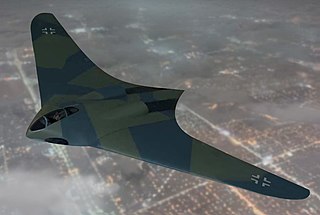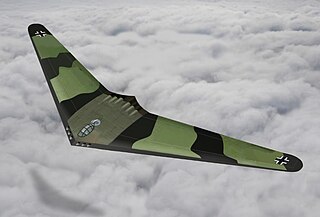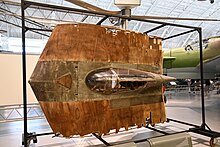
The Dassault Mirage III is a family of single/dual-seat, single-engine, fighter aircraft developed and manufactured by French aircraft company Dassault Aviation. It was the first Western European combat aircraft to exceed Mach 2 in horizontal flight, a feat which was achieved on 24 October 1958.

The Horten H.IX, RLM designation Ho 229 was a German prototype fighter/bomber designed by Reimar and Walter Horten to be built by Gothaer Waggonfabrik. Developed at a late stage of the Second World War, it was the first flying wing to be powered by jet engines.

The Henschel Hs 132 was a World War II dive bomber and interceptor aircraft of the German Luftwaffe that never saw service. The unorthodox design featured a top-mounted BMW 003 jet engine and the pilot in a prone position. The Soviet Army occupied the factory just as the Hs 132 V1 was nearing flight testing, the V2 and V3 being 80% and 75% completed.

The Titan IIIC was an expendable launch system used by the United States Air Force from 1965 until 1982. It was the first Titan booster to feature large solid rocket motors and was planned to be used as a launcher for the Dyna-Soar, though the spaceplane was cancelled before it could fly. The majority of the launcher's payloads were DoD satellites, for military communications and early warning, though one flight (ATS-6) was performed by NASA. The Titan IIIC was launched exclusively from Cape Canaveral while its sibling, the Titan IIID, was launched only from Vandenberg AFB.

The Fairey Aviation Company Fairey III was a family of British reconnaissance biplanes that enjoyed a very long production and service history in both landplane and seaplane variants. First flying on 14 September 1917, examples were still in use during the Second World War.

The Horten H.XVIII was a proposed German World War II intercontinental bomber, designed by the Horten brothers. The unbuilt H.XVIII represented, in many respects, a scaled-up version of the Horten Ho 229, a prototype jet fighter. The H.XVIII was one of many proposed designs for the Langstreckenbomber, and would have carried sufficient fuel for transatlantic flights.

The Horten H.IV was a German tailless flying wing glider in which the pilot was to lie in a prone position to reduce the frontal area, and hence drag. It was designed by Reimar and Walter Horten in Göttingen. Four were built between 1941 and 1943. They were flown in a number of unofficial competitions in Germany during World War II. After the war the flying examples were transported to the United Kingdom and the United States where several contest successes were achieved.

The Swearingen Merlin or the Fairchild Aerospace Merlin is a pressurized, twin turboprop business aircraft first produced by Swearingen Aircraft, and later by Fairchild at a plant in San Antonio, Texas.

The Gloster III was a British racing floatplane of the 1920s intended to compete for the Schneider Trophy air race. A single-engined, single-seat biplane, two were built, with one finishing second in the 1925 race.

The BICh-7 was a tailless sport/touring aircraft designed and built in the USSR from 1929.

The I.Ae. 34 Clen Antú, sometimes known as the Horten XVa after its designer Reimar Horten, was a two-seat tailless glider built in Argentina. Two single-seat variants competed unsuccessfully in the 1952 World Gliding Championships.

The I.Ae.41 Urubú was a two-seat flying wing tailless glider, built in Argentina by the Fábrica Militar de Aviones (FMA) in the 1950s.

The Scheibe Zugvogel is a West German, high-wing, single-seat, FAI Open Class glider that was produced by Scheibe Flugzeugbau. The first version was designed by Rudolph Kaiser and subsequent versions by Egon Scheibe.

The NASA Hyper III was an American unpowered full-scale lifting body remotely piloted vehicle designed and built at the NASA Flight Research Center at Edwards Air Force Base, California.

The DFS Rhönsperber, otherwise known as the Schweyer Rhönsperber or Jacobs Rhönsperber was a single seat competition glider designed in Germany by Hans Jacobs and first flown in 1935. For several years it was regarded as the best German sailplane and about one hundred were built.

The Horten H.II Habicht (Hawk) was a German flying wing glider built in Germany in 1935. Four, including one flown mostly as a motorglider, were built. One of the gliders was used to test the aerodynamics of a prototype World War II Horten jet fighter-bomber.

The Horten H.I was a German flying wing research glider built by Walter and Reimar Horten in 1933.
The LVG D.IV was a German fighter plane built by LVG in World War I.

The Horten H.VII was a flying wing fighter-trainer aircraft designed by the Horten brothers in Nazi Germany during World War II.

The Horten H.XIII was an experimental flying wing aircraft designed by the Horten brothers during World War II.






















